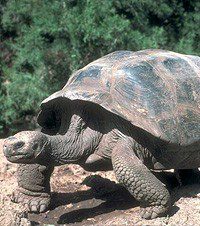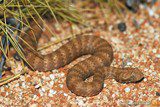
Elephant turtle
The elephant tortoise is a real giant among all representatives of the detachment. This animal is considered a rare species today due to the fact that at one time it was the only available food for sailors. Among the elephant turtles there are giants, reaching 400 kg in weight, and more than a meter in length of the shell. In nature, there are practically no predators for which these reptiles could become prey. Actively destroyed elephant turtles, perhaps, only people. And for the same reason, today they are forced to protect these reptiles, which have significantly decreased in number. The absence of danger to some extent determined the appearance of the elephant tortoise. Its carapace resembles a saddle and is wide open in front. Due to this openness, the elephant tortoise is able to regulate its body temperature in the hot climate of the Galapagos Islands, where it lives. Male elephant tortoises are noticeably larger than females and, due to this size, have always been interesting objects for zoos. But today, all subspecies of this animal, of which there are about 16, are listed in the IUCN Red List. Interestingly, elephant turtles sometimes choose plants that are poisonous to other animals as food. Undoubtedly, this animal can rightly be called the main attraction of the Galapagos Islands. Even Charles Darwin noted how interesting it is to observe the behavior of elephant turtles. In particular, he described such an unusual feature of the animal as deafness. Whether elephant turtles really have hearing problems, the scientist did not explain, but said that the steps of a person who met a turtle and followed it, the animal does not hear and is not frightened until the pursuer falls into its field of vision.
Other names
Chelonoidis elephantopus is the name of a species of elephant tortoise, derived from lat. Chelonoidis (a genus of land turtles).
Testudo elephantopus – the name is derived from lat. Testudines (tortoise order) and Testudinidae (land tortoise family).
Geochelone elephantopus, Chelonoidis nigra, Geochelone nigra, Testudo nigra – lat. species name in combination with lat. nigra (black), a character referring to the predominantly dark color of the shell of the elephant tortoise.
Galápagos giant tortoise, Galápagos tortoise Galapagos tortoise.
The Galapagos tortoise is another well-known name for its habitat.
Classification
Kingdom: Animals
Type: Chord
Subtype: Vertebrates
Class: Reptiles
Order: Turtles
Suborder: Hidden-necked turtles
Family: Land turtles
Genus: American land
skulls
Species: Elephant turtle
Subspecies: abingdonii (Abingdon), becki (Rothschild’s tortoise), chathamensis (Chatham), darvini (Darwin’s tortoise), ephippium (Pinson’s tortoise), duncanensis (Duncan), galopagoensis (Charles Island tortoise), guentheri (Guenther’s tortoise), hoodensis ( Hispaniola), microphyes (Isabelle), nigrita (Black), phantastica (Fernandina tortoise), porteri (Santacruz), vandenburghi (Vandenburg tortoise), vicina (Cave), wallacei (Jervis).
Inhabitation
 A rare, in fact, endangered species of elephant tortoises today has survived only on the Galapagos Islands in the Pacific Ocean, off the coast of Ecuador (South America) and also on the territory of Aldabra Island, which is a national park and located in the Indian Ocean. The areas inhabited by elephant tortoises are distinguished by a hot, dry climate and sparse vegetation. This is mainly a sparse grass cover and rare shrubs and trees. You can also meet elephant turtles in tropical broad-leaved forests, on scrub plains and savannahs, as well as in the lowlands of the Galapagos Islands, covered with solidified lava. In search of fresh water and available vegetation, these reptiles are able to climb winding paths leading to volcanic highlands. Female elephant tortoises prefer the sandy lowlands of the coast, because there it is most convenient for them to lay their eggs, but male elephants climb high on the mountain slopes, because the vegetation there is lush and the air is humid. By the way, elephant turtles living in the lowlands tend to make long journeys in search of sources of fresh water and even tread noticeable paths to them, along which people later found this water at one time.
A rare, in fact, endangered species of elephant tortoises today has survived only on the Galapagos Islands in the Pacific Ocean, off the coast of Ecuador (South America) and also on the territory of Aldabra Island, which is a national park and located in the Indian Ocean. The areas inhabited by elephant tortoises are distinguished by a hot, dry climate and sparse vegetation. This is mainly a sparse grass cover and rare shrubs and trees. You can also meet elephant turtles in tropical broad-leaved forests, on scrub plains and savannahs, as well as in the lowlands of the Galapagos Islands, covered with solidified lava. In search of fresh water and available vegetation, these reptiles are able to climb winding paths leading to volcanic highlands. Female elephant tortoises prefer the sandy lowlands of the coast, because there it is most convenient for them to lay their eggs, but male elephants climb high on the mountain slopes, because the vegetation there is lush and the air is humid. By the way, elephant turtles living in the lowlands tend to make long journeys in search of sources of fresh water and even tread noticeable paths to them, along which people later found this water at one time.
As already mentioned, 16 subspecies of elephant tortoises are known, and their habitat is usually limited to one of the islands. And a hint about which one is often contained in the name of the subspecies. For example, the Abingdon tortoise is found on about. Abingdon (Pinta), mostly in rocky, uneven terrain where volcanic rocks come to the surface. Rothschild’s tortoise has chosen the uneven, bushy northern and western slopes of Wolf Island. Isabela. The Chatham elephant tortoise is easy to find in the northeastern meadows of about. Santa Cristobal. Darwin’s turtle is found on the rocks of about. San Salvador at an altitude of 200 to 700 m above sea level. Pinzon’s tortoise lives on narrow grassy areas on the southwestern slope of the volcano. Gunther’s elephant tortoises inhabit the Sierra Negro mountain system in the southeast of Isabela Island, but are also found on dry plains with rare cacti and trees. The habitat of the Hispaniola tortoise, respectively, the rocks of the island of Hispaniola. Isabelskaya is found within the dry slopes of the Darwin volcano on about. Isabela. The population of the Black elephant tortoise settled in the clearings of about. Santa Cruz and, by the way, is considered the most numerous among all subspecies. The tortoises of Fernandina Island live, respectively, on its volcanic slopes. The Vandenburg elephant tortoise spread not only along the slopes of the Aldero volcano on about. Albemarle, but also occupied its crater. And, finally, the cave elephant turtle chose the Sierra Azul volcano in the south of about. Isabela.
Description
We have already mentioned that the elephant tortoise is a giant of amazing size. Its shell can be up to 120 cm long and 60 cm high. The average weight is 100 kg. And the approximate life expectancy is 150 years. However, the name of the elephant tortoise is due not only to its size, but also to its appearance. To support the heavy and massive body of the reptile, powerful columnar legs are adapted, indeed, reminiscent of elephants. Yes, and her skin on the limbs and neck protruding from under the shell is very reminiscent of a thick rubber-like elephant epidermis. The upper shield of the shell of an elephant tortoise has a special saddle shape – from behind it falls low and slightly bends upwards, and in front, on the contrary, it is raised high, so that the front legs and the long thin neck of the reptile remain practically unprotected. Males have a longer tail with a clear pattern.
Different subspecies of elephant tortoises differ mainly in the size and shape of the shell. On this basis, scientists classified them into two groups. The smallest elephant tortoises live on small arid islands and have longer, thinner legs. Their shell clearly repeats the shape of the saddle, and the weight is about 25-50 kg. In areas with a more humid climate, elephant turtles are also larger. They have a high, dome-like shell. Zoologists suggest that thanks to this form of carpax, elephant turtles are easily introduced into any plant jungle. On the dorsal shield of these reptiles, a pattern is noticeably distinguished in the form of polygons located in each other, by the number of sides of which it is possible to calculate the age of the animal. The elephant turtle is most active during the day, and at night it hides the back of its body in a hole specially dug for this purpose. During the day, the reptile finds salvation from heat and insects by burrowing into silt or liquid mud.
Food
Since the living conditions of elephant turtles are not the most favorable, they are also quite unpretentious in nutrition. The largest part of the diet is plant foods – leaves of shrubs and grass on volcanic slopes, succulent cacti that replace water for turtles, tree lichens and leaves, low-hanging berries and fruits, aquatic vegetation, algae. The main delicacy for elephant turtles is tomatoes. Living in a dry area, the reptile can do without water and food for a long time. However, if the elephant tortoise finds a source of fresh water, then it will drink it little by little for a long time, burrowing into the silt aground. Among the plants that elephant tortoises eat with pleasure are stinging nettles and various thorny bushes that do not cause them any harm. Animal food for a reptile most often becomes a variety of found carrion.
In the terrarium, it is recommended to feed the elephant tortoise with plant foods. In general, this giant is rarely kept at home, more often it is found in various national parks or zoos. There, a completely balanced diet is created for the elephant tortoise, mainly vegetable with a small addition of animal protein.
Reproduction
 In order for the mating of elephant turtles to be successful, nature has provided special tricks in the structure of males. In particular, they have a small notch on the bottom of the shell, which allows them to climb onto the female’s shell and stay on it. If fertilization has happened, then the female elephant tortoise is preparing for laying. Every year she is able to lay her eggs in the same pre-selected warm and safe place. Sometimes the female preliminarily digs several nests in different places in order to choose the most suitable one from them later. In search of a suitable laying place, females often make real trips around the islands. The number of eggs in the elephant tortoise clutch is approximately 2-20 each year from November to April. Moreover, she lays them in the prepared nest very carefully, insuring with the help of a special enveloping liquid, and then just as carefully sprinkles them with earth. In the nest, turtle eggs will “ripen” for a little more than six months – from June to December. And the hatched elephant turtles will dig up the ground and get to the surface on their own.
In order for the mating of elephant turtles to be successful, nature has provided special tricks in the structure of males. In particular, they have a small notch on the bottom of the shell, which allows them to climb onto the female’s shell and stay on it. If fertilization has happened, then the female elephant tortoise is preparing for laying. Every year she is able to lay her eggs in the same pre-selected warm and safe place. Sometimes the female preliminarily digs several nests in different places in order to choose the most suitable one from them later. In search of a suitable laying place, females often make real trips around the islands. The number of eggs in the elephant tortoise clutch is approximately 2-20 each year from November to April. Moreover, she lays them in the prepared nest very carefully, insuring with the help of a special enveloping liquid, and then just as carefully sprinkles them with earth. In the nest, turtle eggs will “ripen” for a little more than six months – from June to December. And the hatched elephant turtles will dig up the ground and get to the surface on their own.
Content
 It is not possible to have a giant elephant tortoise at home due to its huge size. Most often, these reptiles live in various zoos and southern reserves, where spacious enclosures with vegetation and pools are equipped for them. In captivity, elephant tortoises are bred specifically to increase the numbers of an endangered species. In the wild, under the supervision of people, it is not difficult for these reptiles to create suitable conditions, because the most they need is the sun, warmth and the availability of plant foods. The most suitable air temperature for breeding elephant turtles should be + 28- + 33 degrees Celsius.
It is not possible to have a giant elephant tortoise at home due to its huge size. Most often, these reptiles live in various zoos and southern reserves, where spacious enclosures with vegetation and pools are equipped for them. In captivity, elephant tortoises are bred specifically to increase the numbers of an endangered species. In the wild, under the supervision of people, it is not difficult for these reptiles to create suitable conditions, because the most they need is the sun, warmth and the availability of plant foods. The most suitable air temperature for breeding elephant turtles should be + 28- + 33 degrees Celsius.
Sources of
http://ru.wikipedia.org
http://www.floranimal.ru
http://www.cherepahi.ru
http://www.zooclub.ru
http://allforpets.com.ua/
http://www.zoodrug.ru
http://www.styleakcent.ru
http://cherepashnik.ucoz.ru/





